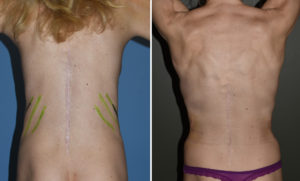Background: The conventional forms of waistline reshaping are a tummy tuck and liposuction. These procedures will work well for the aesthetic needs of the vast majority of women. Numerous variations exist within these procedure to trying magnify their effects such as horizontal fascial plication in tummy tucks and aggressive liposuction techniques for maximal fat reduction along the waistline and into the back.
But for some women conventional waistline surgery does not achieve their desired result or is either not indicated or has already been done. One such type of patient is the already thin female. They do not have enough fat for liposuction and their abdomen does not have enough lose tissue to justify a tummy tuck. They often have an already the waistline and low body fat. Their aesthetic problem is that their mid-torso silhouette is straight and they desire a more inward waistline shape.
For this type of female waistline patient the last anatomic barrier for change lies beneath the fat and fascia of the abdominal and back muscles. Further change must come from removal of the bony support of the lateral waistline from the free floating ribs. Their natural outward flare can be felt by pushing inward on the waistline. The removal of their tip projecting points allows further inward positioning of the horizontal waistline at the level of the umbilicus.
Case Study: This 30ish year-old female sought to improve her already thin body frame with a straight line lateral waistline shape. She worked out regularly and had a very strict diet but could not he desired waistline shape. She had prior back surgery and already had a midline back scar.
Under general anesthesia and in the prone position, she had subtotal rib removals of ribs #10,11 and 12 through an oblique 5 cm back incision. Each rib was sectioned at the lateral border of the erector spine muscle. Ribs # 11 and 12 was removed laterally by separating the soft tissue from their cartilaginous tips. Rib #10 was removed laterally by separating the bony part from the cartilaginous anterior extension.

Highlights:
1) One third of all patients that seek rib removal surgery for horizontal waistline reduction are already very thin and seek an ‘extreme’ waistline change.
2) All rib removal surgery involves back scars which are the aesthetic tradeoff of the procedure.
3) When considering rib removal surgery ones to consider the balance between the existence of back scars vs the amount of waistline reduction achieved.
Dr. Barry Eppley
Indianapolis, Indiana



